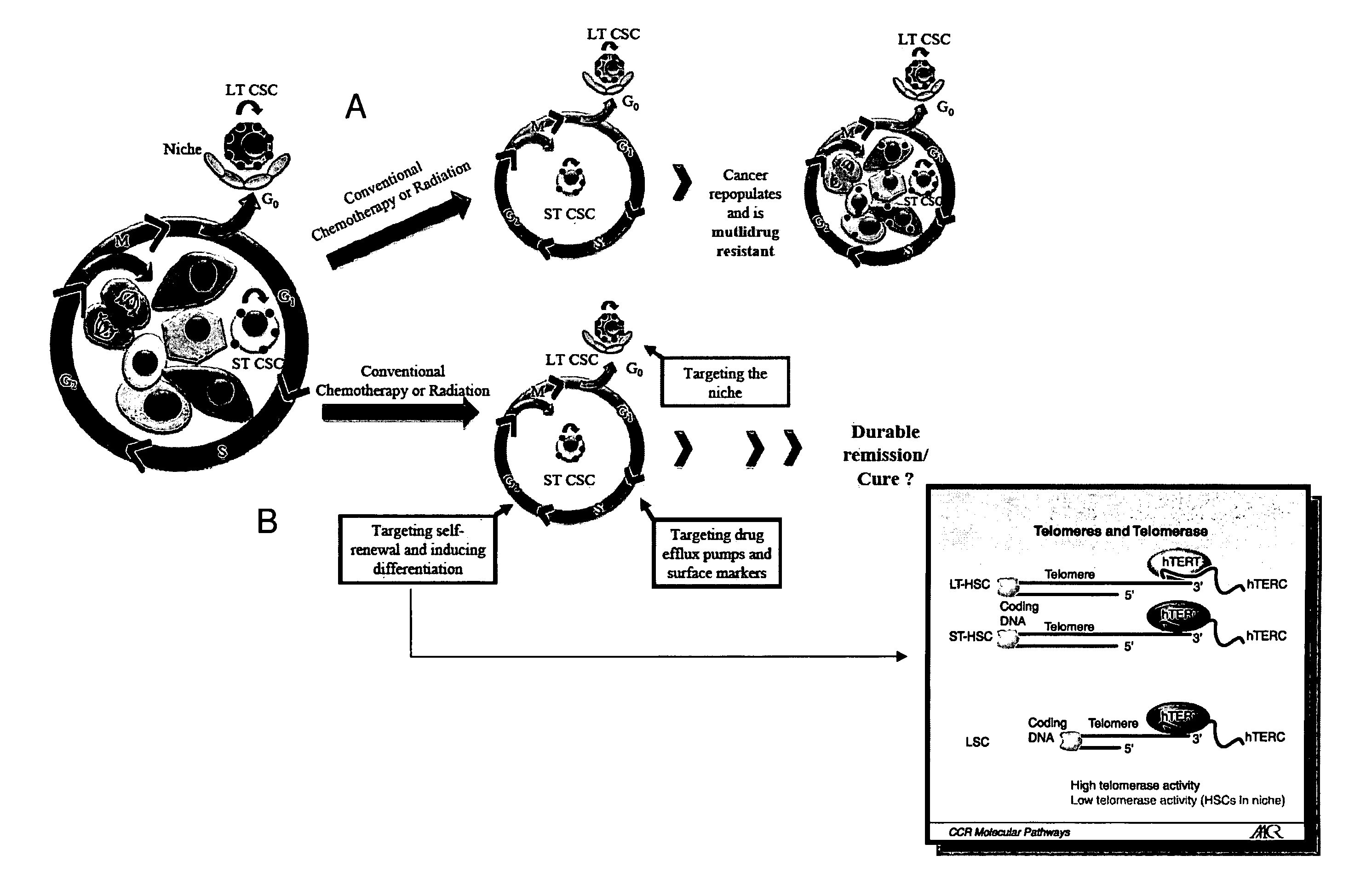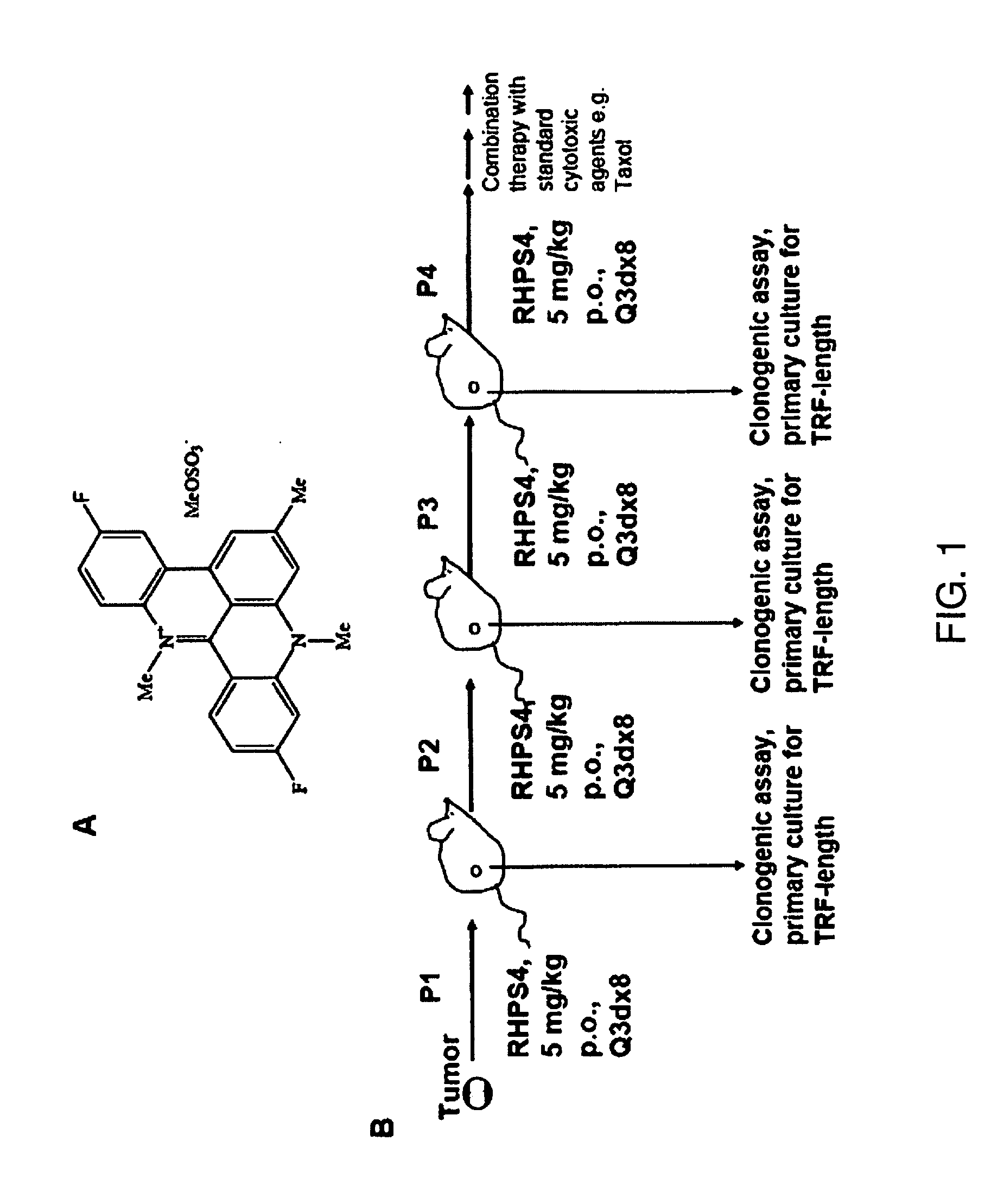Telomere targeting agents as stem cells directed treatments
a technology of stem cells and targeting agents, applied in the field of cell biology, molecular biology, cancer biology, etc., can solve the problems of bulk tumor cells being killed, difficult to treat by conventional anti-cancer agents, and ineffective stem cell directed therapies, etc., to achieve the effect of increasing the proliferation of non-cancerous stem cells
- Summary
- Abstract
- Description
- Claims
- Application Information
AI Technical Summary
Benefits of technology
Problems solved by technology
Method used
Image
Examples
example 1
Exemplary Methods and Materials
[0167]RHPS4 was synthesized as described (Heald et al 2002). RHPS4 is water-soluble and was therefore dissolved in phosphate buffered saline (PBS). For in vitro studies paclitaxel (Taxol) was purchased from Sigma (St. Louis, Mo.) and dissolved in dimethylsulfoxide (DMSO); for in vivo experiments the clinical formulation was used and obtained Cremophor from Bristol-Myers Squibb, New York, N.Y.
[0168]The UXF1138L uterus carcinoma cell line was originally established from a patient tumor by Prof. Heiner Fiebig at the University of Freiburg, Germany (Fiebig and Burger, 2001). All animal experiments were conducted under an animal license approved by the German Federal Government (Regierungspräsidium Freiburg) and in compliance with the UKCCCR guidelines on experimental neoplasia (Workman et al., 1998). Six to eight weeks old female thymus aplastic nude mice of NMRI genetic background were used for establishment and serial propagation of the human tumor xenog...
example 2
Effects of RHPS4 on Clonogenic Cell Growth In Vitro
[0182]The growth inhibitory activity of RHPS4 in human bulk tumor cells have been compared, by MTT assay, against RHPS4 activity in tumor cells grown as colonies in the clonogenic assay, also termed the human tumor stem cell assay (HTCA) (FIG. 2A-B). HEK293T human embryonic kidney cells grown in the HTCA, and cord blood cells cultured in methylcellulose were also treated with RHPS4 (FIG. 2C). The MTT assay is a 5 day proliferation test measuring effects on a morphologically heterogeneous, differentiated cell population (bulk cells), whereas the HTCA and methylcellulose assays are longer term (10-15 day) tests in which only a very small fraction of a bulk culture (˜0.1-1%) will grow as colonies. Cells growing anchorage-independently as colonies in a semi-solid matrix are considered to be pluripotent stem cells (Hamburger & Salmon, 1977; Locke et al., 2005; Fiebig et al. 2004). FIG. 2A shows a comparison of responses to RHPS4 in two t...
example 3
RHPS4's Effects on Normal Stem Cells
[0183]To assess RHPS4 effects on normal stem cells, the human embryonic kidney cell line HEK293T was exposed to drug in the MTT and HTCA assays, and tested RHPS4 effects on colony forming units of the mononuclear cell fraction of human cord blood in methyl cellulose (FIG. 2C). The cord blood colony assay was performed with and without colony stimulating growth factors, only methylcellulose containing growth factors grew colonies. Interestingly, RHPS4 concentrations that inhibited colony formation by human embryonic kidney and cord blood (>1 mircoM) cells were over 25-fold above those inhibiting tumor cell colony formation (FIG. 2C). Additionally, in normal cell types as compared to tumor cells, low and pharmacodynamically relevant concentrations of RHPS4 (0.01 to 1 microM) did induce colony formation (FIG. 2C). To assure that the induction of colony growth by RHPS4 in normal stem cells is reproducible, cord blood from three different individuals a...
PUM
| Property | Measurement | Unit |
|---|---|---|
| Molar density | aaaaa | aaaaa |
| Molar density | aaaaa | aaaaa |
| Concentration | aaaaa | aaaaa |
Abstract
Description
Claims
Application Information
 Login to View More
Login to View More - R&D
- Intellectual Property
- Life Sciences
- Materials
- Tech Scout
- Unparalleled Data Quality
- Higher Quality Content
- 60% Fewer Hallucinations
Browse by: Latest US Patents, China's latest patents, Technical Efficacy Thesaurus, Application Domain, Technology Topic, Popular Technical Reports.
© 2025 PatSnap. All rights reserved.Legal|Privacy policy|Modern Slavery Act Transparency Statement|Sitemap|About US| Contact US: help@patsnap.com



